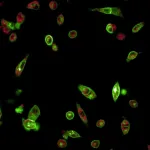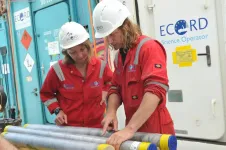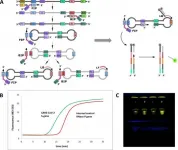(Press-News.org) For decades, climate change researchers and activists have used dramatic forecasts to attempt to influence public perception of the problem and as a call to action on climate change. These forecasts have frequently been for events that might be called "apocalyptic," because they predict cataclysmic events resulting from climate change.
In a new paper published in the International Journal of Global Warming, Carnegie Mellon University's David Rode and Paul Fischbeck argue that making such forecasts can be counterproductive. "Truly apocalyptic forecasts can only ever be observed in their failure--that is the world did not end as predicted," says Rode, adjunct research faculty with the Carnegie Mellon Electricity Industry Center, "and observing a string of repeated apocalyptic forecast failures can undermine the public's trust in the underlying science."
Rode and Fischbeck, professor of Social & Decision Sciences and Engineering & Public Policy, collected 79 predictions of climate-caused apocalypse going back to the first Earth Day in 1970. With the passage of time, many of these forecasts have since expired; the dates have come and gone uneventfully. In fact, 48 (61%) of the predictions have already expired as of the end of 2020.
Fischbeck noted, "from a forecasting perspective, the 'problem' is not only that all of the expired forecasts were wrong, but also that so many of them never admitted to any uncertainty about the date. About 43% of the forecasts in our dataset made no mention of uncertainty."
In some cases, the forecasters were both explicit and certain. For example, Stanford University biologist Paul Ehrlich and British environmental activist Prince Charles are serial failed forecasters, repeatedly expressing high degrees of certainty about apocalyptic climate events.
Rode commented "Ehrlich has made predictions of environmental collapse going back to 1970 that he has described as having 'near certainty'. Prince Charles has similarly warned repeatedly of 'irretrievable ecosystem collapse' if actions were not taken, and when expired, repeated the prediction with a new definitive end date. Their predictions have repeatedly been apocalyptic and highly certain...and so far, they've also been wrong."
The researchers noted that the average time horizon before a climate apocalypse for the 11 predictions made prior to 2000 was 22 years, while for the 68 predictions made after 2000, the average time horizon was 21 years. Despite the passage of time, little has changed--across a half a century of forecasts; the apocalypse is always about 20 years out.
Fischbeck continued, "It's like the boy who repeatedly cried wolf. If I observe many successive forecast failures, I may be unwilling to take future forecasts seriously.
That's a problem for climate science, say Rode and Fischbeck.
"The underlying science of climate change has many solid results," says Fischbeck, "the problem is often the leap in connecting the prediction of climate events to the prediction of the consequences of those events." Human efforts at adaptation and mitigation, together with the complexity of socio-physical systems, means that the prediction of sea level rise, for example, may not necessarily lead to apocalyptic flooding.
"By linking the climate event and the potential consequence for dramatic effect," noted Rode, "a failure to observe the consequence may unfairly call into question the legitimacy of the science behind the climate event."
With the new Biden administration making climate change policy a top priority, trust in scientific predictions about climate change is more crucial than ever, however scientists will have to be wary in qualifying their predictions. In measuring the proliferation the forecasts through search results, the authors found that forecasts that did not mention uncertainty in their apocalyptic date tended to be more visible (i.e., have more search results available). Making sensational predictions of the doom of humanity, while scientifically dubious, has still proven tempting for those wishing to grab headlines.
The trouble with this is that scientists, due to their training, tend to make more cautious statements and more often include references to uncertainty. Rode and Fischbeck found that while 81% of the forecasts made by scientists referenced uncertainty, less than half of the forecasts made by non-scientists did.
"This is not surprising," said Rode, "but it is troubling when you consider that forecasts that reference uncertainty are less visible on the web. This results in the most visible voices often being the least qualified."
Rode and Fischbeck argue that scientists must take extraordinary caution in communicating events of great consequence. When it comes to climate change, the authors advise "thinking small." That is, focusing on making predictions that are less grandiose and shorter in term. "If you want people to believe big predictions, you first need to convince them that you can make little predictions," says Rode.
Fischbeck added, "We need forecasts of a greater variety of climate variables, we need them made on a regular basis, and we need expert assessments of their uncertainties so people can better calibrate themselves to the accuracy of the forecaster."
INFORMATION:
Parenthood leads to greater reductions in short-term research productivity for mothers across three disciplines than for fathers, largely explaining the publication gender gap between women and men in academia, according to an analysis of survey data from 3,064 tenure track faculty at PhD-granting universities in the U.S. and Canada. The findings suggest that policies designed to boost workplace flexibility for parents, including easily accessible lactation rooms and affordable childcare, may help to ease the impact of parenthood on mothers in academia, giving them more time for research. While a large body of previous research across academic fields has shown that men tend to publish more papers than women, the reasons for this have remained uncertain. ...
Scientists have found that comparing the ratio of two immune molecules helped predict the likelihood of transplant rejection in 339 patients who received kidney transplants, the only curative treatment for late-stage kidney failure. Their results suggest that monitoring this ratio could help distinguish high-risk patients early on, before long-term organ rejection becomes inevitable, allowing clinicians to intervene accordingly with new treatments. Kidney transplants often grant immediate benefits to patients with end-stage kidney disease, but long-term outcomes are mixed, as 35% of transplant recipients lose their new kidney within ...
Cancer cells can experience stress. They have to contend with attacks by the immune system or with anti-cancer therapeutics. If they attempt to colonize other tissues, they have to break away from the extracellular matrix, enter the bloodstream and survive during the travel through the body. Then exit and start building a new colony. The ability of cells to adapt their properties to face all the challenges they encounter is called plasticity. In epithelial solid tumors, including the very common lung, breast, colon and pancreatic cancers, tumor cells plasticity hijacks a cellular development process known as epithelial-mesenchymal transition (EMT).
EMT is commonly associated to kinases - enzymes that act like a switch, turning biochemical ...
Targeted radiation is often used to study and treat diverse cancer types. A multidisciplinary research team based at the University of Chicago Medicine has recently focused on a type of cell that releases a protein that enhances resistance to cancer therapies and promotes tumor progression.
The study focused on Ter cells, which are extra medullary erythroid precursers that secrete the neuropeptide artemin. In the study, published February 24, 2020, in Science Translational Medicine, the researchers showed that local tumor radiotherapy, systemic immunotherapy or the combination of both treatments were able to deplete Ter cells in the spleen, reduce artemin production and limit tumor progression both in the locally irradiated tumors as well as outside ...
Researchers believe they have closed the case of what killed the dinosaurs, definitively linking their extinction with an asteroid that slammed into Earth 66 million years ago by finding a key piece of evidence: asteroid dust inside the impact crater.
Death by asteroid rather than by a series of volcanic eruptions or some other global calamity has been the leading hypothesis since the 1980s, when scientists found asteroid dust in the geologic layer that marks the extinction of the dinosaurs. This discovery painted an apocalyptic picture of dust from the vaporized asteroid and rocks from impact circling the planet, blocking ...
COLUMBUS, Ohio - Politicization of the COVID-19 pandemic had a powerful influence over adherence to social distancing guidelines in the United States and why people did, or did not, comply during the lockdown days, a new study has found.
The analysis boiled down to whom study participants trusted most: scientists or President Donald Trump.
"People who expressed a great deal of faith in President Trump, who thought he was doing an effective job of guiding us through the pandemic, were less likely to socially distance," said Russell Fazio, senior author of the study and a professor ...
Ultra-fast, cheap LAMP-based COVID tests could be performed by non-experts at work and in public spaces, giving results in under an hour
INFORMATION:
Article Title: "Ultra-rapid detection of SARS-CoV-2 in public workspace environments"
Funding: This project was made possible through the support of a grant from Dynamic Combinatorial Chemistry, LLC, The funder provided support in the form of salaries and supplies for authors OY, ZY, JM, and BO, but did not have any additional role in the study design, data collection and analysis, decision to publish, or preparation of the manuscript. The specific ...
Improving road safety in cities could result in a lower rate of violent crime, according to research from UCL.
Experts analysing crime and car accident data in Mexico City found a surprisingly high level of synchronicity between the two on a weekly cycle, suggesting that applying more resources to prevent road accidents would improve crime rates by enabling more efficient policing.
For the paper, published today in Cities as Complex Systems special issue in PLOS ONE, experts plotted the time and locations of nearly one million car accidents and 200,000 ...
CLEVELAND, Ohio - Researchers at University Hospitals Rainbow Babies & Children's Hospital (UH Rainbow) published new findings today that wearing a face mask - either a cloth mask or a surgical mask - did not impair the ability of subjects to get air in and out of their bodies.
The study measured heart rate, transcutaneous carbon dioxide tension, and oxygen levels in 50 adult volunteers at the conclusion of six 10-minute phases: Sitting quietly and then walking briskly without a mask; sitting quietly and then walking briskly while wearing a cloth mask; and sitting quietly and then walking ...
WATERTOWN, Mass. - Gene therapy has traditionally been conceptualized as a one-time, curative treatment option; however, research shows that there may be a need for subsequent doses years after initial treatment. While adeno-associated viral (AAV) vectors are a core part of this powerful therapeutic approach, they present two key challenges in gene therapy.
The first challenge is their immunogenicity. In gene therapy, the formation of neutralizing antibodies (Nabs) in response to AAV vector administration precludes retreatment of a patient due to the potentially dangerous immune response that would occur after a second or third administration of the therapy.
The second obstacle relates to their durability. AAV vectors ...


